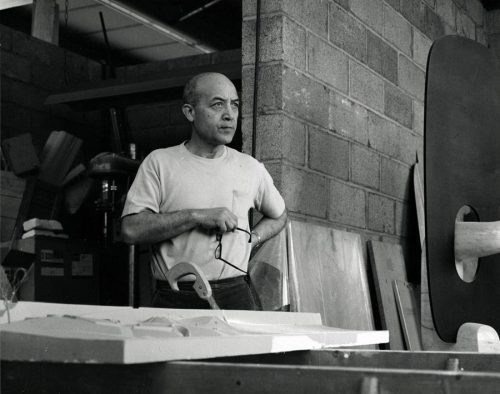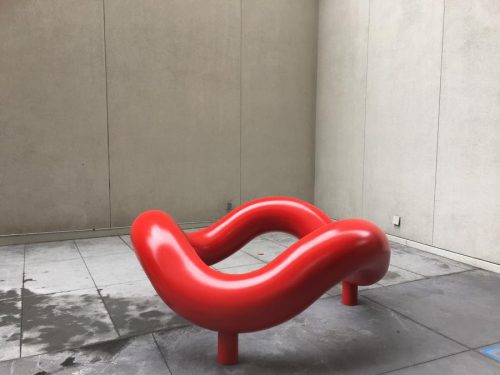
The Portland Museum of Art (PMA) is honored to announce it will open Beyond the Pedestal: Isamu Noguchi and the Borders of Sculptureon October 5, 2018. This exhibition of approximately 40 sculptures and 10 works on paper is a rare Maine retrospective of Isamu Noguchi (1904-1988), the Japanese-American artist who became a central figure in the development of 20th-century American modernism. The exhibition runs through January 6, 2019.
Beyond the Pedestal examines the ways Noguchi reimagined the possibilities of sculpture over the course of his 60-year career. The show brings together varied aspects of Noguchi’s expansive production—which included traditional sculpture, landscape architecture, memorials, stage sets, interior designs, furniture, and more—highlighting the artist’s belief that the sculptor’s role was “to order and animate space.” Noguchi was as comfortable creating monuments and gardens as he was collaborating to produce industrial design and stage sets. Juxtaposed across the exhibition, his works complicate notions of form and function and use the mix of materials, shapes, and techniques to encourage audiences to reimagine their sense of what sculpture can be.
In 1986, just two years before he died, Noguchi served as the American representative at the Venice Biennale—the most-prestigious international contemporary art exhibition of the time. The show, which the artist titled Isamu Noguchi: What is Sculpture?, confounded many critics in its diversity of styles and materials. Nevertheless, it got to the heart of Noguchi’s ambition to investigate sculpture’s potential to inform social spaces and spur physical, intellectual, and even spiritual engagement between audiences and artworks.
This question—“what is sculpture?”—is the starting point for Beyond the Pedestal, an exhibition that allows PMA audiences to examine the artist’s driving interest in the relationships between people, objects, and spaces.

Isamu Noguchi believed that the interaction between people, his artworks and their environments was crucial for the perception of space and that movement—like volume, line, and proportion—was central to the process for engaging sculpture.
The bronze cast of Play Mountain, for example, reveals Noguchi’s first foray in landscape design. The table-top sculpture is a plan for an environment that Noguchi envisioned would fill an entire city block. Believing that play could offer the potential for children to experience sculpture and the city through physical interaction, Noguchi broke from the standards of New York City playgrounds as fenced-in, asphalt-covered lots, and instead imagined sculpting the earth itself to create slides, steps, and curves. Although his vision was never made into reality, the model served as a touchstone for him throughout his life.

Noguchi’s interest in movement surfaced in his art in various forms. With works such as Play Sculpture, individuals can understand their own space and relation to art by moving around the undulating, serpentine forms. In considering additional relationships of sculpture and movement, Noguchi collaborated with architects, inventors, and performers. He frequently partnered with choreographers such as Martha Graham and Erick Hawkins to develop stage sets that fostered the performative movement of dance. By creating the sculptural structure for these environments, as he did with Jungle Gym, Noguchi offered audiences new ways to see the world of dance.
Isamu Noguchi was committed to examining all facets of the relationship between human experience and sculpture, leading him to engage crucial causes of social justice through his art. In the 1930s through the 1950s, he designed sculptures that considered issues that shook both American culture and global society.
In the 1940s, Noguchi voluntarily entered the Poston War Relocation Center—a federal detention center for Japanese-American citizens during the Second World War—where he stayed for seven months. Though he had hoped to humanize the environment through art, his sculptures from this time reveal his pain and disillusionment as he confronted his isolation and American xenophobia. Some of these powerful works, including Yellow Landscape and My Arizona, will be on view in Beyond the Pedestal. Other works in this section of the exhibition, including Monument to Ben Franklin, suggest the artist’s negotiation of his own American identity, while sculptures such as Monument to Heroes serve as a painful meditation on the human costs of war.
DOMESTIC LANDSCAPES
Beyond the Pedestal also explores how Isamu Noguchi’s expansive understanding of his medium led him to sculpt numerous objects that could traditionally be classified as interior decor. Rather than simply create lights, chairs, and tables that conformed to modernist furniture conventions, however, he crafted furniture that recalled other examples of his sculpture as well as sculpture that evoked his design concepts. His free-form sofa and ottoman, for example, more closely suggest the river stones he used in his gardens than the stark lines of contemporary modernist couches. On the other hand, the composition of the layered metal planes in Lingaconjures the idea of a recognizable folded table.
Noguchi collaborated extensively when developing his sculpted interior pieces. For his Akari lamps, for instance, he worked with a manufacturer in Gifu, Japan, and he partnered with the American industrial manufacturer Knoll on his rocking stools. He took pleasure in the way these works could be produced industrially, making his sculpture available to a broader audience, and felt no concern that a commercial practice would devalue his aesthetic. While many of these forms appear iconic to our 21st-century eyes, when Noguchi created them in the middle of the last century they fundamentally altered the perception of the link between furniture and sculpture.
Beyond the Pedestal: Isamu Noguchi and the Borders of Sculpture has been co-organized by the Portland Museum of Art, Maine and The Isamu Noguchi Foundation and Garden Museum.
Generously supported in part by:
Eileen T. Gillespie and Timothy Fahey
Karen L. McDonald
Christina F. Petra
David E. Shaw
Foundation Support: The Japan Foundation, New York
Corporate Sponsor: KeyBank sponsorship is made in honor of Sterling Kozlowski.
Media Sponsors:
Artscope
Maine Public
With an extensive collection and nationally renowned exhibitions, the Portland Museum of Art (PMA) is the cultural heart of Maine. The PMA boasts significant holdings of American, European, and contemporary art, as well as iconic works from Maine—highlighting the rich artistic tradition of the state and its artists. The museum brings it all to life with unparalleled programming. From special events, family activities, and community conversations to PMA Films, curator talks, and tours of the Winslow Homer Studio—it’s all happening at the PMA.
The museum is located at Seven Congress Square in downtown Portland.
Summer Hours: Monday, Tuesday, Wednesday, Saturday, and Sunday 11 a.m. to 6 p.m.; Thursday and Friday 11 a.m. to 8 p.m.
Winter Hours: Wednesday, Saturday, and Sunday 11 a.m. to 6 p.m.; Thursday and Friday 11 a.m. to 8 p.m.
Admission is $15 for adults, $13 for seniors, and $10 for students. Everyone age 21 and under is free thanks to the generosity of Susie Konkel. Admission is free every Friday from 4 p.m. to 8 p.m. No admission is required to visit the PMA Café and PMA Store.
Winslow Homer Studio tours are available by reservation. For more information, call (207) 775-6148 or visit portlandmuseum.org.
Categories: Portland, Portland Museum of Art
Tags:

